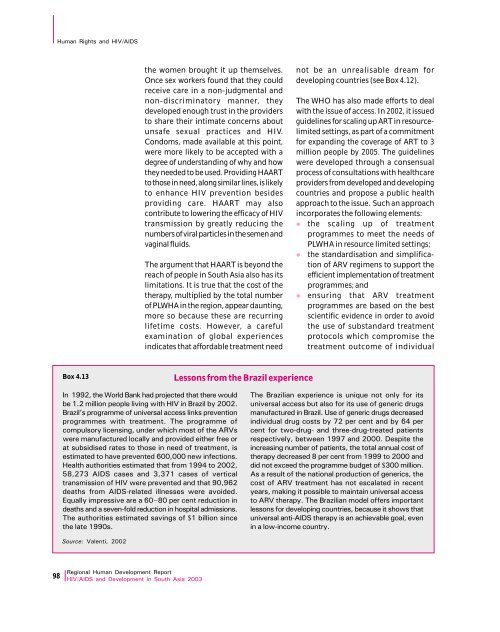Download Report - UNDP Asia-Pacific Regional Centre - United ...
Download Report - UNDP Asia-Pacific Regional Centre - United ...
Download Report - UNDP Asia-Pacific Regional Centre - United ...
You also want an ePaper? Increase the reach of your titles
YUMPU automatically turns print PDFs into web optimized ePapers that Google loves.
Human Rights and HIV/AIDSthe women brought it up themselves.Once sex workers found that they couldreceive care in a non-judgmental andnon-discriminatory manner, theydeveloped enough trust in the providersto share their intimate concerns aboutunsafe sexual practices and HIV.Condoms, made available at this point,were more likely to be accepted with adegree of understanding of why and howthey needed to be used. Providing HAARTto those in need, along similar lines, is likelyto enhance HIV prevention besidesproviding care. HAART may alsocontribute to lowering the efficacy of HIVtransmission by greatly reducing thenumbers of viral particles in the semen andvaginal fluids.The argument that HAART is beyond thereach of people in South <strong>Asia</strong> also has itslimitations. It is true that the cost of thetherapy, multiplied by the total numberof PLWHA in the region, appear daunting,more so because these are recurringlifetime costs. However, a carefulexamination of global experiencesindicates that affordable treatment neednot be an unrealisable dream fordeveloping countries (see Box 4.12).The WHO has also made efforts to dealwith the issue of access. In 2002, it issuedguidelines for scaling up ART in resourcelimitedsettings, as part of a commitmentfor expanding the coverage of ART to 3million people by 2005. The guidelineswere developed through a consensualprocess of consultations with healthcareproviders from developed and developingcountries and propose a public healthapproach to the issue. Such an approachincorporates the following elements:l the scaling up of treatmentprogrammes to meet the needs ofPLWHA in resource limited settings;l the standardisation and simplificationof ARV regimens to support theefficient implementation of treatmentprogrammes; andl ensuring that ARV treatmentprogrammes are based on the bestscientific evidence in order to avoidthe use of substandard treatmentprotocols which compromise thetreatment outcome of individualBox 4.13Lessons from the Brazil experienceIn 1992, the World Bank had projected that there wouldbe 1.2 million people living with HIV in Brazil by 2002.Brazil’s programme of universal access links preventionprogrammes with treatment. The programme ofcompulsory licensing, under which most of the ARVswere manufactured locally and provided either free orat subsidised rates to those in need of treatment, isestimated to have prevented 600,000 new infections.Health authorities estimated that from 1994 to 2002,58,273 AIDS cases and 3,371 cases of verticaltransmission of HIV were prevented and that 90,962deaths from AIDS-related illnesses were avoided.Equally impressive are a 60–80 per cent reduction indeaths and a seven-fold reduction in hospital admissions.The authorities estimated savings of $1 billion sincethe late 1990s.The Brazilian experience is unique not only for itsuniversal access but also for its use of generic drugsmanufactured in Brazil. Use of generic drugs decreasedindividual drug costs by 72 per cent and by 64 percent for two-drug- and three-drug-treated patientsrespectively, between 1997 and 2000. Despite theincreasing number of patients, the total annual cost oftherapy decreased 8 per cent from 1999 to 2000 anddid not exceed the programme budget of $300 million.As a result of the national production of generics, thecost of ARV treatment has not escalated in recentyears, making it possible to maintain universal accessto ARV therapy. The Brazilian model offers importantlessons for developing countries, because it shows thatuniversal anti-AIDS therapy is an achievable goal, evenin a low-income country.Source: Valenti, 200298<strong>Regional</strong> Human Development <strong>Report</strong>HIV/AIDS and Development in South <strong>Asia</strong> 2003
















